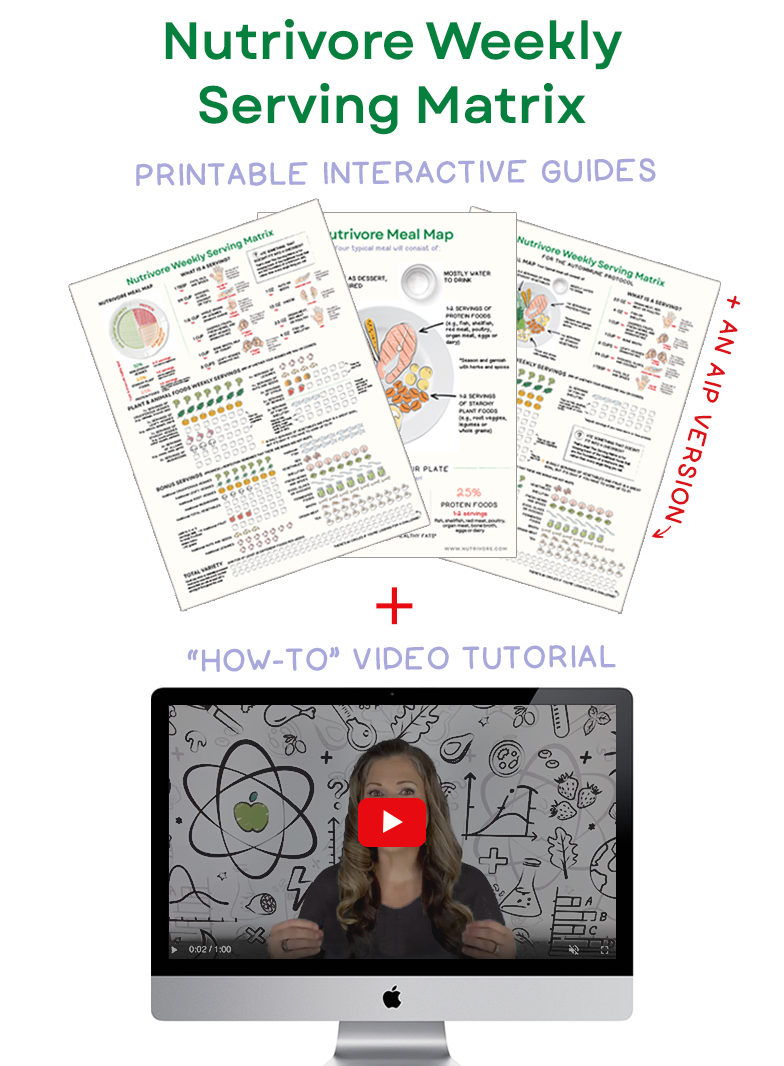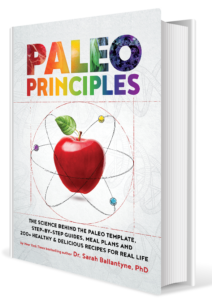 What do cupcake sprinkles, M&Ms, and bright orange macaroni and cheese have in common (apart from being totally not Paleo)? The answer is: food dyes! Synthetic food dyes are a class of colorings derived from petroleum, and are used to by food manufacturers (or even chefs) to alter or enhance the color of foods. On ingredients labels, food dyes have names like Red 40, Yellow 5, Blue 1, and sometimes just “artificial color.” (Keep in mind, synthetic food dyes are different than natural food pigments, like beet extract and grape skin extract, which can also be used to color foods!)
What do cupcake sprinkles, M&Ms, and bright orange macaroni and cheese have in common (apart from being totally not Paleo)? The answer is: food dyes! Synthetic food dyes are a class of colorings derived from petroleum, and are used to by food manufacturers (or even chefs) to alter or enhance the color of foods. On ingredients labels, food dyes have names like Red 40, Yellow 5, Blue 1, and sometimes just “artificial color.” (Keep in mind, synthetic food dyes are different than natural food pigments, like beet extract and grape skin extract, which can also be used to color foods!)
Food dyes are often lumped in with other artificial additives and preservatives as ingredients we should avoid when eating Paleo. But, why exactly are they harmful? Dyes are definitely worth a closer look so we can understand exactly how they affect our health!
Over the years, the FDA has banned the use of many dyes due to evidence of harm. But, the FDA still approves of nine artificial dyes for use in food (Blue 1, Blue 2, Citrus Red 2, Green 3, Orange B, Red 3, Red 40, Yellow 5, and Yellow 6), and there’s a great deal of concern about whether these dyes are truly safe for us.
As with any food ingredient, it’s hard to study the long-term effects of food dyes in humans (since we can’t create rigorous, controlled studies that last for years and years!). But, multiple lines of evidence suggest that even the FDA-approved food dyes are bad news. In rodent studies, a number of artificial dyes have been shown to induce malignant cell transformation, increase tumor incidence, damage DNA in the stomach and colon, and increase total mortality (depending on the dye and the species and strain of rodent). One study found that the soaking liquid from commercial red ginger pickles induced DNA damage in the rodent colon, glandular stomach, and bladder. Blue 2 has resulted in a statistically significant increase in brain gliomas (a type of tumor) in male rats, and red 3 has been shown to act as a thyroid carcinogen. And, for certain common dyes (like Red 2, Red 40, and Yellow 5), DNA damage in mouse gastrointestinal organs happens even at low doses close to the acceptable daily intake.
 When we look at the molecular properties of artificial dyes, it’s not hard to see why they could contribute to cancer in a variety of mammals. Some of the most widely used food dyes (particularly Red 40, Yellow 5, and Yellow 6, which make up 90% of the dyes used in foods in the US) contain benzidine, a chemical carcinogen that doesn’t occur in nature. Although the FDA tests for levels of free benzidine in food dyes and factors that into safety assessments, bound benzidine (which can be released by our intestinal enzymes and contribute to our total exposure) isn’t documented by FDA tests. So, consuming certain food dyes may result in higher exposures to this carcinogen than generally believed. And, that means that the FDA’s acceptable daily intake levels (which are based on intakes where no adverse effects are observed) could be higher for certain food dyes than they should be (in other words, even lower levels could be harmful).
When we look at the molecular properties of artificial dyes, it’s not hard to see why they could contribute to cancer in a variety of mammals. Some of the most widely used food dyes (particularly Red 40, Yellow 5, and Yellow 6, which make up 90% of the dyes used in foods in the US) contain benzidine, a chemical carcinogen that doesn’t occur in nature. Although the FDA tests for levels of free benzidine in food dyes and factors that into safety assessments, bound benzidine (which can be released by our intestinal enzymes and contribute to our total exposure) isn’t documented by FDA tests. So, consuming certain food dyes may result in higher exposures to this carcinogen than generally believed. And, that means that the FDA’s acceptable daily intake levels (which are based on intakes where no adverse effects are observed) could be higher for certain food dyes than they should be (in other words, even lower levels could be harmful).
In 2010, the Center for Science in the Public Interest (CSPI) published a report called “Food Dyes: A Rainbow of Risks” that questioned the safety of dyes still approved for human consumption. The report noted that along with seven of the FDA-approved dyes contributing to cancer in lab animals, four dyes are linked to uncommon but severe allergic reactions, yellow 5 has been shown to exacerbate asthma in certain people (especially those with cross-sensitivity to aspirin), and some studies suggest dyes may contribute to behavioral problems (including impaired performance in hyperactive children, increases in aversive behavior, ADHD, restlessness, and sleep disturbance).
Likewise, many existing safety studies on food dyes suffer from design flaws, including: rodent studies lasting only two years, and therefore missing the diet-related cancers that don’t show up until their third year of life; studies using relatively few animals; and lack of testing of combinations of food dyes versus individual dyes, since mixing them could compound certain adverse effects. And, as of right now, the FDA doesn’t require food dyes to be tested for developmental neurotoxicity, so their safety for growing children is a question mark. In other words, our existing studies on food dyes aren’t strong enough to confirm their safety (especially in light of their known carcinogenic properties and potential neurological effects!).
 Considering the level of artificial dyes many people ingest, all of the above should be a major concern. Due to the increase of processed foods in the American diet over the decades, our intake of food dyes is now five times as much as it was 60 years ago. The food industry puts over 15 million pounds of artificial dyes into our food supply each year! And, sometimes those dyes end up in less-than-obvious places (like sausage coatings and orange peels, which are sometimes colored with Citrus Red No. 2, both of which may be considered Paleo foods). And, even if you’re avoiding artificial dyes in foods, you may still be exposed in medications, especially OTC liquid formulations for children. (By contrast, many non-US countries use plant-based colorings instead of artificial petroleum-based dyes. For example, in Britain, McDonald’s strawberry sundaes are colored with real strawberry, while the same item in the US uses Red 40. And, in Europe, most foods with artificial dyes are required to have a warning label saying the dye “may have effects on activity and attention in children.”)
Considering the level of artificial dyes many people ingest, all of the above should be a major concern. Due to the increase of processed foods in the American diet over the decades, our intake of food dyes is now five times as much as it was 60 years ago. The food industry puts over 15 million pounds of artificial dyes into our food supply each year! And, sometimes those dyes end up in less-than-obvious places (like sausage coatings and orange peels, which are sometimes colored with Citrus Red No. 2, both of which may be considered Paleo foods). And, even if you’re avoiding artificial dyes in foods, you may still be exposed in medications, especially OTC liquid formulations for children. (By contrast, many non-US countries use plant-based colorings instead of artificial petroleum-based dyes. For example, in Britain, McDonald’s strawberry sundaes are colored with real strawberry, while the same item in the US uses Red 40. And, in Europe, most foods with artificial dyes are required to have a warning label saying the dye “may have effects on activity and attention in children.”)
Considering artificial food dyes contribute no nutrition to our diets and are totally unnecessary for staying healthy, there’s really no reason to consume them. But, is there anything we can do if we want to color foods in a healthy way? Fortunately, there is! Natural (non-petroleum-based) foods colorings are available (check out India Tree food coloring), beet juice can impart red or pink color, cacao powder can tint foods brown, and various spices (such as turmeric which colors foods a vibrant yellow) can also act as food colorings—without any of the risks associated with artificial dyes!
Citations
Ardern KD & Ram FS. “Tartrazine exclusion for allergic asthma.” Cochrane Database Syst Rev. 2001;(4):CD000460.
“Color Additive Status List.” U.S. Food and Drug Administration. December 2015.
Potera C. “DIET AND NUTRITION: The Artificial Food Dye Blues.” Environ Health Perspect. 2010 Oct; 118(10): A428.
Nutrivore Weekly Serving Matrix
An easy-to-use and flexible weekly checklist
to help you maximize nutrient-density.
The Weekly Serving Matrix is very helpful! I’ve been eating along these lines but this really helps me know where to focus vs. which foods serve a more secondary role. It’s super helpful and has taken a lot of worry out of my meal planning. Thanks!
Jan
Price PJ, et al. “In vitro and in vivo indications of the carcinogenicity and toxicity of food dyes.” Int J Cancer. 1978 Mar 15;21(3):361-7.
Rowe KS & Rowe KJ. “Synthetic food coloring and behavior: a dose response effect in a double-blind, placebo-controlled, repeated-measures study.” J Pediatr. 1994 Nov;125(5 Pt 1):691-8.
Sasaki YF, et al. “The comet assay with 8 mouse organs: results with 39 currently used food additives.” Mutat Res. 2002 Aug 26;519(1-2):103-19.
Stevens LJ, et al. “Mechanisms of behavioral, atopic, and other reactions to artificial food colors in children.” Nutr Rev. 2013 May;71(5):268-81.
Swanson JM & Kinsbourne M. “Food dyes impair performance of hyperactive children on a laboratory learning test.” Science. 1980 Mar 28;207(4438):1485-7.
Tsuda S, et al. “DNA damage induced by red food dyes orally administered to pregnant and male mice.” Toxicol Sci. 2001 May;61(1):92-9.
Weiss B, et al. “Behavioral responses to artificial food colors.” Science. 1980 Mar 28;207(4438):1487-9.
Weiss B. “Vulnerability of children and the developing brain to neurotoxic hazards.” Environ Health Perspect. 2000 Jun; 108(Suppl 3): 375–381.











